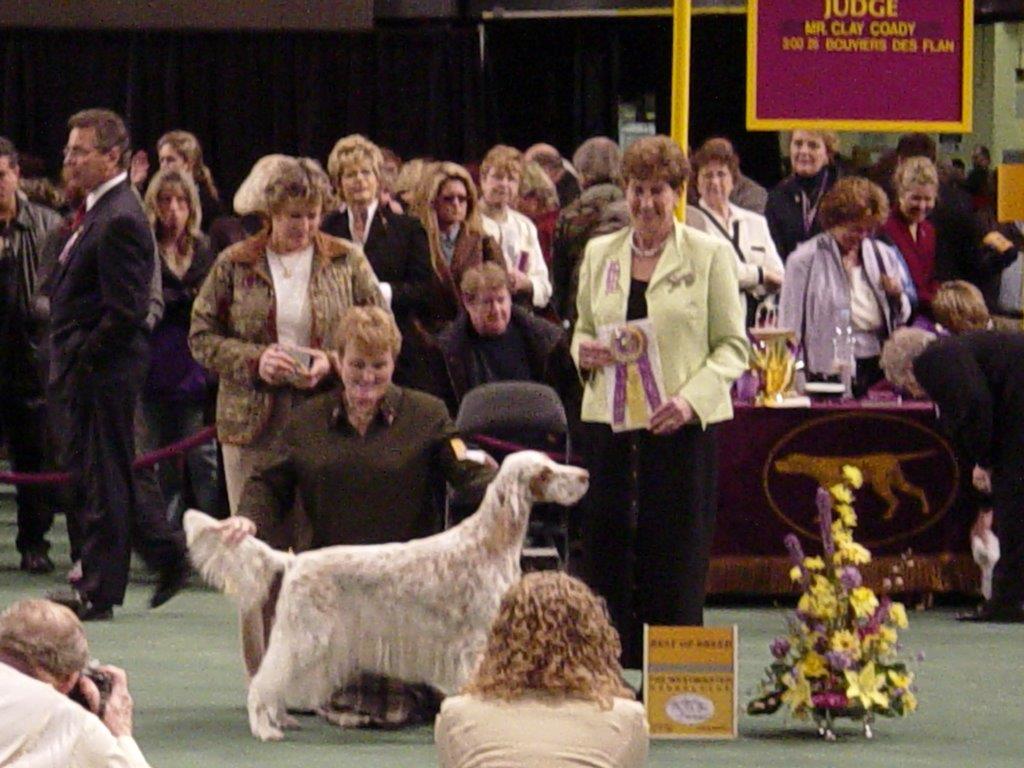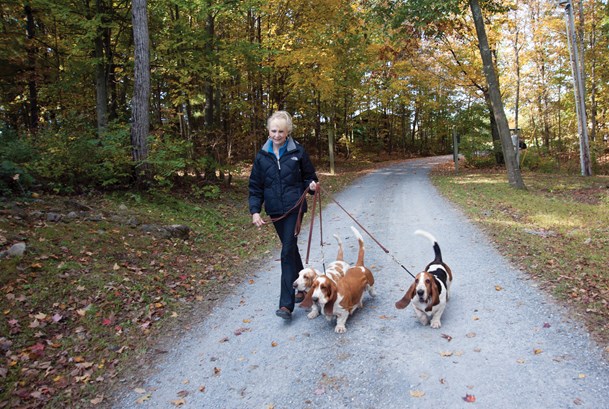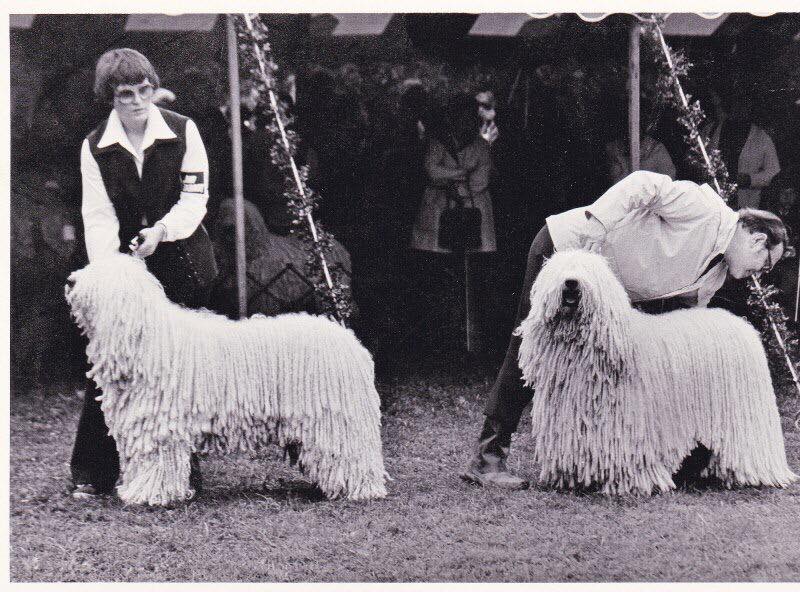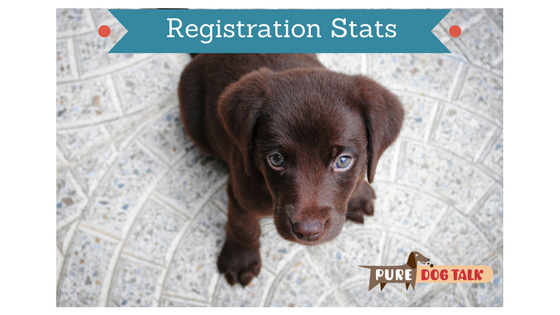170 – Ann Yuhasz, Four Generation Family of Dog Breeders
ANN YUHASZ, FOUR GENERATION FAMILY OF DOG BREEDERS
We talk a lot about pedigrees in dogs, but AKC Judge Ann Yuhasz and her family have been involved in dogs, specifically English Setters, since the 1960s. Yuhasz noted that starting with her mother, to herself, to her daughter, to now her granddaughter, purebred dogs are an inextricable part of their “family DNA.”
SPECIAL RELATIONSHIPS
Yuhasz shares memories of her mother, Nancy Frey, and her daughter, Rebecca, and the special relationships the purebred dog world has brought her
“It was unbelievably valuable,” Yuhasz said. “(Mother and I) had such a very special relationship. I understood what she was doing. She understood what I was doing and it was remarkable…. she was my best friend. She really was. And there’s a big hole when your best friend has gone. And still to this day I sometimes think she’s sitting on my shoulder laughing at me for whatever I’m doing.”
She also discusses the challenges and rewards of judging the sporting group, a numerically large, diverse group of dogs used for every type of bird hunting.
“…the sporting group is basically pointers, setters, retrievers and spaniels. … those four are very different, yet very much alike. They all hunt. They all should hunt. They all should be made so they can hunt. And if you can keep that in mind when you judge them then you should be okay.”
While English Setters were her family’s lifetime passion, Yuhasz spent a number of years working with Flat Coated Retrievers. They aren’t black Golden Retrievers, although they are considered the progenitor breed of the Golden Retriever.
“…the Flat Coat is essentially a pickup dog,” Yuhasz said. “He sat there all day while they shot and then he went out with his buddies and cleaned the field. That’s what he did. And he’s a very, very sweet creature. They are very touchy-feely, they want to be with you, they make lousy kennel dogs but they are very unique. Their head property is so different and so hard to find correctly.”
PASSION FOR BREEDING AND JUDGING
Yuhasz brings passion and excitement to her love of dogs, of breeding, of judging.
“That’s how I feel about some of these dogs,” Yuhasz added. “I can’t wait to get my hands on them, you know? I mean, Good Heavens. So that’s what judging’s all about – getting your hands on wonderful dogs and admiring what somebody has done.
“If you can get a litter with one good specimen – my goodness that’s terrific! If you can get a bunch of good specimens, how fabulous is that? How lucky you are! The genes just fell just the right way. You got the things you were looking for, and I think as breeders you’ve got to have a pattern … you’ve got to know where to go how to go and you have to be hard on yourself. You’ve gotta say, ‘Mmm, that isn’t it.’”
I hope you enjoy my talk with Ann and that her passion can inspire you as much as it did me!
168 – Breeder Education Advocate Claudia Orlandi Shares Knowledge
CLAUDIA ORLANDI ON EDUCATION AND DOG BREEDING
AN EARLY “EYE FOR A DOG”
Orlandi grew up with miniature and standard Poodles, but her first show dog was a Saint Bernard from Betty Roberts. When her family visited the breeder to pick a puppy, somehow the divider between the “show” dogs and the “pet” dogs had fallen down. With an “eye for a dog” at even an early age, the puppy her family chose led Orlandi into a life of dog shows. Eventually, shown by Bob Forsyth, that Saint Bernard became a Best in Show Winner.
“…structure and performance or, form following function, are the key characteristics of breed type and are what distinguish one breed from another.”
Horses and dogs were a passion she shared with her first husband, Dom. They acquired their first Basset Hound from a pack in Vermont. There they learned the functional aspect of their hound by following the pack on rabbit hunts. Orlandi now lives part-time in Spain, where she had just returned from a month of hunting with her hounds when we spoke for this interview.
“… I have to say that having had the experience of hunting with Emma (her first Basset) was a great starting point for really understanding the basset hound breed,” Orlandi said. “…structure and performance or, form following function, are the key characteristics of breed type and are what distinguish one breed from another.”
Orlandi attributes much of her knowledge of anatomy and animal husbandry to the 4-H program. In her shout out to the horse 4-H program she noted, “We had to pass difficult written and hands on tests on equine anatomy and movement, in addition to giving presentations and learning animal husbandry. All of this knowledge relating to horses, I was easily able to apply to breeding and showing dogs.”
But as she progressed in her breeding program, she came to understand that other breeders didn’t have the same good fortune.
“If we to learn about photography we can go to photography school,” Orlandi said. “If you want to become better cooks, we can take cooking classes. But at that time, we really didn’t have anything comparable if we wanted to learn to become better breeders.”
Knowledge is power, Orlandi noted, in everything that we do. So, she began to develop her education programs and books, including the fabulous Basset Hound University program she created and has shared with other Parent Clubs. She insists that breeders can be successful with some basic information to help them move forward.
Some of her best recommendations?
- …the concept of preservation breeding is an extremely important topic that deserves our ongoing support and attention.
- …one of the biggest myths is the belief that because breeding revolves around chance and randomness applying genetic principles won’t make a difference. Nothing could be farther from the truth. In reality, it’s very unlikely that a breeder can consistently produce healthy, quality dogs in which every generation the dogs are better than they were in the previous generations, without understanding how traits are passed from one generation to the next.
- …don’t purchase a bitch younger than 12 to 18 months. If you get a bitch much younger than this, they have not been able to do enough health tests and body structure might still be developing.
- …I think it’s really difficult, in a way, to find a good person to work with in a breeding program or to find a mentor. Because in a way it’s kind of like a marriage. I think you have to be psychologically compatible and you have to have a lot of the same goals and the same beliefs in common.
- … a few decades ago if people were honest about health problems they are absolutely shunned, many times, by their peers. Talking about health was considered taboo. Nowadays, we understand much more about controlling canine genetic disease and we know that if we’re honest about the health problems, about who the affected dogs are in our pedigrees we can control health problems in our breeding program very, very easily. But it all revolves around being honest.
Please enjoy my visit with this legendary advocate for breeder education in purebred dogs.
167 – Komondor Breeder Anna Quigley on Cords and Clubs
ANNA QUIGLEY – ON THE KOMONDOR, CORDS AND CLUBS
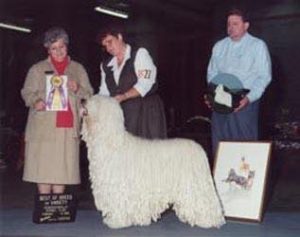
Ch. Lajosmegyi’s Patent Pending
Anna Quigley is synonymous, for many in the purebred dog world, with a 110-pound, powerful, white mop. She bred, owned and handled the three-time national specialty winner, best in show winner, Westminster Kennel Club group winner that took the Komondor breed to new heights in the 1990s.
45 YEARS DEVOTED TO THE KOMONDOR
But it all started with a Rough Collie. She met her long-time breeding partner and friend, Patricia Turner, when Quigley brought her female to Turner’s stud dog to be bred. Indeed, Quigley housesat when Turner drove to California to bring home her first Komondor. Thus Bobo, and a long, successful family of robust, corded guardian dogs, entered Quigley’s life in 1973. Quigley, Turner and their extended families have been involved in the breed together for the duration of the intervening 45 years.
Quigley and Turner acquired a second Komondor from show photographer Ken O’Brien and their foundation bitch from Salt Lake City. Although Quigley noted the bitch wasn’t perfect, she had important breed qualities. They bought their foundation stud dog, Tiger, from Dottie Collier in 1976, having only ever communicated with Collier over the phone or by letter.
“There was room for people in the breed and we managed to become successful. The breed has been very good to us,” Quigley said.
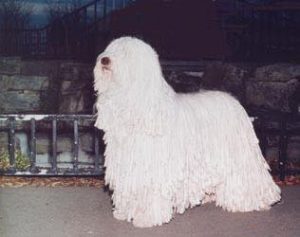
Ch. Lajosmegyi Far and Away
Komonodorok are not a breed that will ever become popular, Quigley noted, primarily due to the coat and the intense work required to maintain it correctly. She said a fully coated Komondor requires anywhere from seven to 10 hours to dry. I have clear memories of watching Quigley leash walk the dogs at shows with their coats tied up and tube socks on their feet.
“Here in Western Washington, we have a lot of gravel area for the dogs because it’s so wet,” Quigley said. She added that the breed’s native Hungary and parts of Europe, where the dogs still serve their traditional roles as livestock guardians, are typically far drier climates.
The breed, like many in Europe, was nearly wiped out at the end of World War II, but Quigley noted the world wide estimated population in recent years has approached 10,000.
The breed was recognized by the AKC in 1932 and the Komondor Club of America worked proactively to expand the gene pool early on.
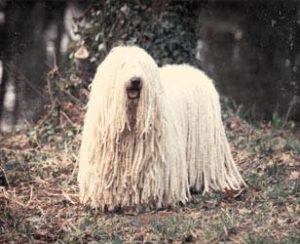
Summithill Save The Tiger
“Well, when we first joined the Komondor Club of America,” Quigley noted, “one of the requirements was that you could not breed any closer than three generations back. And that was to help expand the lines and create different lines.”
Quigley said it’s tough breeding a Komondor litter these days. The number of breeders, and consequently the number of dogs being exhibited, has decreased since its heyday in the late 20th century.
“… when we bought Tiger from Dottie, he was 10 months old,” Quigley said. “And he was out of an outside female and it was her puppy back. So, he was a little bit different pedigree than the rest of her litters. … often when he was used for stud, instead of taking a stud service, if the pedigree was right on the female, we would take a puppy back. …. my comment to Pat (while considering a particular stud dog) was we always agreed we’d breed to the devil if it could improve our line.”
Dahu, the dog who won the group at the garden under Irene Bivin, was originally placed in a home because Quigley and Turner didn’t want to keep another male at the time.
“We went down to see him and he was tied to a tree in the back yard,” Quigley said. “And very much willing to bite somebody. And the family really didn’t like him. So, he came back. And he just easily worked his way into our hearts and he was totally reliable with everybody in the family, but he knew how to bite. Which of course you don’t want a dog to figure out. But I went to a lot of work to open up my heart and my mind to suggestions on how to get this stopped and we did.”
Quigley and Turner would drive a couple hours each way to a handling class near Seattle to work with Dahu. “(the instructor) always tried to convince me… when he’d do the down and back, he would have a tendency to jump straight up in the air,” Quigley said. “And she said just ‘trust him to come down and be right.’ That night (in the group at Westminster Kennel Club) he jumped straight up in the air and I trusted him, and he came down in a perfect gait.”
I hope you enjoy this wonderful talk with one of the greats in our sport. Her knowledge, wisdom, humor and dedication are an inspiration.
And stick around for Allison Foley’s *excellent* advice on treating problem ears.
166 – Mark Dunn: AKC Registration Trend Reversal
AKC REGISTRATION REVERSES 20 YEAR TREND
According to Mark Dunn, AKC Senior Vice President of Registration and Customer Development, more breeders are registering more dogs, reversing a 20-year downtrend.
MARK DUNN BREAKS DOWN THE REGISTRATION STATISTICS
The last four years have shown notable increases in the number of dogs registered. Mark Dunn tells us that the number of litters registered and the number of people breeding dogs are also on the rise.
“…it says something about the role that AKC Breeders are playing in getting dogs into American homes. Which is really important to all of us, to be there for people who love dogs,” Dunn said
Good news on the overall increasing number of registrations is tempered somewhat by a different trend in the low-number breeds. Dunn notes that while the Top 10 breeds have been booming, the bottom 60 breeds are in decline or showing noteworthy reduction in registrations. Labrador Retrievers, for example, represent 15 percent of ALL dogs registered in more than 200 breeds.
Some of the lower registration breeds are new to AKC registration and working to improve their numbers, while other ancient breeds like Otterhounds and Dandie Dinmont Terriers struggle to maintain their popularity.
“I want to be there for parent clubs and provide any information or help those breeders need,” Dunn said.
The Breeder of Merit program was established seven years ago. Dunn believes it had a vital impact on these increasing registrations. Today, nearly a quarter of AKC registrations are produced by BOM approved breeders or those on that path, he noted.
Research indicates that Americans LOVE their dogs. Ninety million of them, in fact. With average lifespans, an estimated 8 million “replacement” dogs are required to meet the annual demand by dog owners in the US. Dunn says AKC breeders produce 1.3 million, with another several million available through shelter placement.
“… THERE IS STILL A LOT OF ROOM FOR GROWTH FOR AKC BREEDERS AND RESPONSIBLE BREEDERS THAT ARE WILLING TO DO WHAT WE EXPECT BREEDERS TO DO TO BREED AKC DOGS,” DUNN SAID. “I THINK WE HAVE A GREAT OPPORTUNITY IF WE CAN FIND WAYS TO GROW RESPONSIBLY. AND TO DO THE RIGHT THING FOR DOGS AND FOR THE PEOPLE WHO LOVE THEM.”
The low registration breeds are a popular topic in this area. Dunn noted that during his presentation to the AKC Delegate’s Parent Club committee, he was asked about marketing rare breeds to increase demand.
“The worst thing we can do is make a hard-to-find breed more popular,” Dunn said. “… if we simply try to market our way to success for particular breeds, we can create a real problem. …if we drive demand for a hard-to-find breed, someone is going to go try to fulfill that demand. Unfortunately, it might not be the parent club breeders and it might not be the people that are … most concerned about the proper stewardship of that breed.”
As registration and breeder numbers increase, Dunn advocates continuing the positive direction with specific actions, including education.
“So, what we saw last year,” Dunn said, “was a lot of growth in the number of people breeding that are not currently considered either commercial, by any definition. They only bred one litter with AKC. They’re very low volume. Maybe one or two litters tops. But they’re not currently on track to be a Breeder of Merit so they either have not finished dogs or they are not competing in conformation to any large extent. Now half of those breeders are very new. They’re either new as in last year was the first time they showed up on our radar. Or they’re new because they’ve shown up once or twice in the last two or three years. The real key is to bring those people in. To bring them along. And the way we do that is through education.”
Here at Pure Dog Talk, we’re happy to offer education to new and old alike! Hope you enjoy my talk with Mark.

